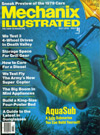|
|
AquaSub
|
|||||
|
|
As Featured on Cover of Mechanix Illustrated Magazine
![]()
Plans Include ten 17 x 22
inch drawings & a 24-page photo-illustrated instruction manual.
Order AquaSub Plans Now $45
(order a second item to get a discount & free shipping)
|
Essential Resources for the Do-It-Yourselfer
AquaSub is built of fiberglass over urethane foam, and reinforced with a simple steel framework. She is equipped with two outrigger pontoons, which are attached by wing-like structures that are hinged at their connection points to the central occupant pod. When running on the surface, the pontoon-tipped wings are outstretched and level with the occupant pod. As AquaSub submerges, the wings fold at the attachment points, allowing the central pod to slip below the surface. At maximum depth, the wings bottom against stops to limit the depth. As a safety measure, pontoons are large enough to keep AquaSub afloat, even if the occupant pod were to flood with water. We coined the name "snorkel-sub" to describe the way air is snorkeled in from above. Air is taken in through a standpipe in the right pontoon where a blower forces it through the wing structure and into the cabin through a vent over the operator's right shoulder. Fresh air is directed across the acrylic windows where it sweeps around and exits through a vent over the left shoulder. Air is then expelled through the left wing structure and out the standpipe on the left pontoon. The continuous flow of air washing across the windows keeps them from fogging, and it lends an open, fresh-air feeling to the inside. Flow rate provides about 20 changes of cabin air per minute. Propulsion and direction control come from two electric trolling motors, one mounted under each wing. Propulsion motors, as well as the fresh-air blower, are powered by two 6-volt golf car batteries located in the bow. Batteries provide enough electrical power for about 4 hours of continuous running. Steering is done by switching one of the propulsion motors off, or into reverse, while leaving the other motor running in the opposite direction. AquaSub can travel forward at walking speed, back up, or spin around on its axis. Ballast tanks are built into the occupant pod, one along each side. To submerge, a lever located to the side of the operator actuates a valve that lets air out of the ballast tanks through a small vent in front of the canopy. This allows water to rush into the tanks through open flood ports underneath the sub. To surface, compressed air from a cylinder suspended inside the occupant pod is release into the ballst tanks to force water out through the flood ports. Although flood ports are always open to the water, air pressure inside the ballast tanks keeps water from entering. The large cylinder suspended underneath the occupant pod (visible in the photos) holds lengths of rebar that provide the extra weight necessary to pull her underwater when the ballast tanks are flooded. And just in case the operator were to submerge without enough compressed air to re-surface, the rebar-cylinder can be released by pulling a lever inside the cabin causing AquaSub to rise to the surface, even with flooded ballast tanks.
|
|||




